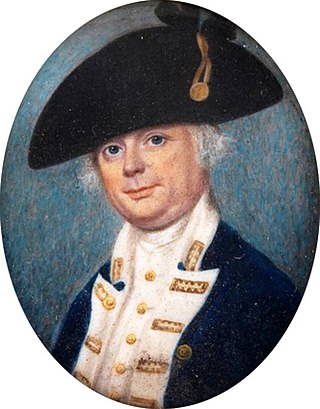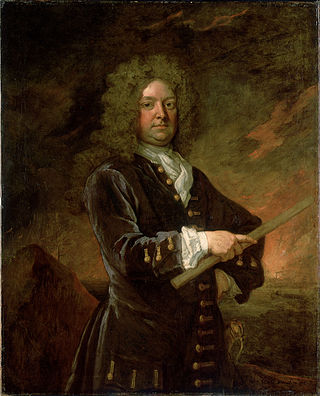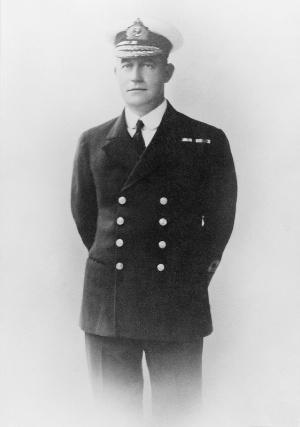
The Battle of Jutland was fought on 31 May and 1 June 1916, in the waters of the North Sea, between forces of the Royal Navy and Imperial German Navy. The battle involved 250 warships, and, in terms of combined tonnage of vessels engaged, was the largest naval battle in history.

The North America and West Indies Station was a formation or command of the United Kingdom's Royal Navy stationed in North American waters from 1745 to 1956, with main bases at the Imperial fortresses of Bermuda and Halifax, Nova Scotia. The North American Station was separate from the Jamaica Station until 1830 when the two combined to form the North America and West Indies Station. It was briefly abolished in 1907 before being restored in 1915. It was renamed the America and West Indies Station in 1926. It was commanded by Commanders-in-Chief whose titles changed with the changing of the formation's name, eventually by the Commander-in-Chief, America and West Indies Station.

Admiral of the Fleet John Cronyn Tovey, 1st Baron Tovey,, sometimes known as Jack Tovey, was a Royal Navy officer. During the First World War he commanded the destroyer HMS Onslow at the Battle of Jutland and then commanded the destroyer Ursa at the Second Battle of Heligoland Bight. During the Second World War he initially served as Second-in-Command of the Mediterranean Fleet in which role he commanded the Mediterranean Fleet's Light Forces. He then served as Commander-in-Chief of the Home Fleet and was responsible for orchestrating the pursuit and destruction of the Bismarck. After that he became Commander-in-Chief, The Nore with responsibility for controlling the east coast convoys and organising minesweeping operations.

Francis William Drake was an officer of the Royal Navy. He served during the War of the Austrian Succession, the Seven Years' War and the American War of Independence, rising to the rank of vice-admiral of the red.

Admiral of the Fleet Sir John Leake was a Royal Navy officer and politician. As a junior officer he saw action at the Battle of Texel during the Third Anglo-Dutch War. He then distinguished himself when he led the convoy that broke the barricading boom at Culmore Fort thereby lifting the siege of Derry during the Williamite War in Ireland. As a captain he saw action in some of the heaviest fighting at the Battle of Barfleur and was also involved in a successful attack on the French ships at the Battle of La Hogue during the Nine Years' War.

Admiral Sir George Francis Hyde, was an English-born Australian admiral, known as a former head and the first officer to achieve the rank of full admiral in the Royal Australian Navy.

The Commander-in-Chief South Atlantic was an operational commander of the Royal Navy from 1939. The South American area was added to his responsibilities in 1960, and the post disestablished in 1967.

The Action of 16 March 1917 was a naval engagement in which the British armed boarding steamer SS Dundee and HMS Achilles, a Warrior-class armoured cruiser, fought the German auxiliary cruiser SMS Leopard, which sank with the loss of all 319 hands and six men of a British boarding party.
SS Dundee was a British steamship that was built in Scotland in 1911 and sunk by enemy action in the Celtic Sea in 1917. She was designed as a coastal passenger and cargo liner for the Dundee, Perth & London Shipping Company Ltd, but in 1915 she was converted into an armed boarding steamer for the Royal Navy. She took part in the Action of 16 March 1917, was sunk by a U-boat six months later, and lost members of her crew in both actions.

Admiral Sir Geoffrey Nigel Oliver was a Royal Navy officer during the Second World War.
Rear-Admiral Hubert Edward Dannreuther, DSO was a British admiral and one of six survivors of the sinking of HMS Invincible during the battle of Jutland.

Vice-Admiral Sir Edward Henry Fitzhardinge Heaton-Ellis, KBE, CB, MVO was a British Royal Navy officer.

Admiral Sir Arthur Cavenagh Leveson GCB was a senior officer in the Royal Navy. He was the Rear Admiral Commanding His Majesty's Australian Fleet from 9 January 1917 to 3 September 1918 and later Commander in Chief, China Station from 10 September 1922 to 22 April 1925.

SMS Leopard was a British cargo steamship that was built in 1912 as Yarrowdale, captured in 1916 by the Imperial German Navy, converted into a commerce raider in Germany, and sunk with all hands by the Royal Navy in 1917.
Vice Admiral John Collings Taswell Glossop, was a British Royal Navy officer best known for captaining the Australian cruiser HMAS Sydney during the Battle of Cocos in which the German cruiser SMS Emden was sunk.

Mikhail Aleksandrovich Kedrov was a Russian naval officer who served in the Imperial Russian Navy during the Russo-Japanese War, World War I and the Russian Civil War.
Admiral Charles Duncan Johnson, CB, DSO, MVO was a Royal Navy officer who became Admiral Superintendent of Malta Dockyard.

Vice-Admiral Sir Charles Douglas Carpendale, CB was a Royal Navy officer who saw active service in the First World War and later served as Controller of the British Broadcasting Corporation.

Rear-Admiral Sir Thomas Hardy was a Royal Navy officer of the late 17th and early 18th centuries. Having joined the navy sometime before 1688, Hardy's career was supported by Captain George Churchill, whom he served as first lieutenant during the Battle of Barfleur in 1692. Promoted to captain in 1693, Hardy served in the Channel Islands and off the coast of England until 1702 when he was given command of HMS Pembroke off the coast of Spain. He fought at the Battle of Cádiz, and subsequently discovered the location of the Franco-Spanish fleet through the intervention of his chaplain, which resulted in the Battle of Vigo Bay. Hardy was knighted for his services.
Captain Sir Andrew Leake was a Royal Navy officer of the late seventeenth and early eighteenth centuries, who distinguished himself at the Battle of Vigo Bay, during the War of the Spanish Succession. From Lowestoft, Leake joined the navy in 1688 under the patronage of John Ashby. Promoted to commander, Leake fought under Ashby as a supernumerary at the Action at La Hogue in 1692. His services at La Hogue brought him promotion to captain, and a series of commands that culminated in 1702 with Leake joining HMS Torbay. At Vigo Bay later that year Torbay broke the boom protecting a Franco-Spanish treasure fleet, resulting in the capture or destruction of the entire fleet. Leake was knighted for this, and went on to command HMS Grafton at the Capture of Gibraltar in 1704. He was mortally wounded at the Battle of Málaga later the same year.













